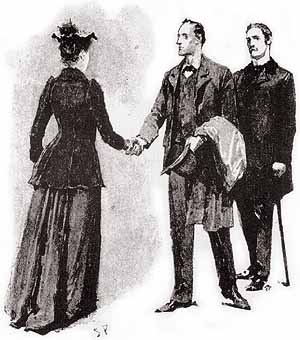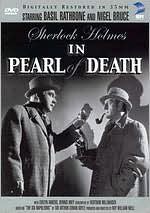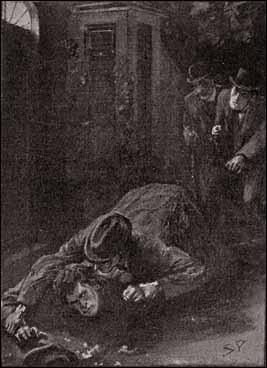As part of an ongoing project on my Twitter feed, I'm delivering stories from the Sherlock Holmes canon in tiny installments of 140 characters or less. Last week, I finished up "The Blue Carbuncle," and I hope you enjoyed this seasonal tale, which Christopher Morely once described as: "Surely one of the most unusual things in the world: a Christmas Story without slush."
The current story is "The Adventure of the Copper Beeches," and I wonder if you will agree with Sherlock Holmes when he says: "I confess that it is not the situation which I should like to see a sister of mine apply for."
Check out my Twitter feed for a daily installment, although I am usually inspired to post more than once a day. And don't forget you can read through the original canon online.
Monday, December 12, 2011
Sunday, December 4, 2011
Sherlock Holmes on Screen: “The Pearl of Death” (1944)
“Gentlemen,” he cried, “let me introduce you to the famous black pearl of the Borgias…it is the most famous pearl now existing in the world, and it has been my good fortune, by a connected chain of inductive reasoning, to trace it from the Prince of Colonna’s bedroom at the Dacre Hotel, where it was lost, to the interior of this, the last of the six busts of Napoleon which were manufactured by Gelder & Co., of Stepney. You will remember, Lestrade, the sensation caused by the disappearance of this valuable jewel, and the vain efforts of the London police to recover it. I was myself consulted upon the case, but I was unable to throw any light upon it.” (“The Six Napoleons”)
Outside of his 1939 production of “The Hound of the Baskervilles,” the Sherlock Holmes films starring Basil Rathbone were only tangentially linked to the stories of the canon, at best. In many instances, Sir Arthur Conan Doyle’s original stories could be more accurately viewed as source material, rather than any real type of blueprint. They provided a framework, not any real form. But in 1944’s “The Pearl of Death,” when Basil Rathbone’s Sherlock Holmes advises Nigel Bruce’s Dr. Watson against hitting newspaper reporters in the teeth (an affectionate, though misguided, attempt at defending the Detective’s honor), there is more than an echo of Holmes’s original sentiment: “The Press, Watson, is a most valuable institution, if you only know how to use it."
“The Pearl of Death” also marked the introduction of a new adversary for the Great Detective, provided by Universal Pictures in the form of Giles Conover, the jewel thief. Perhaps the studio felt that audiences had seen enough of Professor Moriarty, but unfortunately Conover embodies many of the Professor’s most prominent characteristics anyway. According to Sherlock Holmes, “This man pervades Europe like a plague, yet no one has ever heard of him. That’s what puts him on the pinnacle in the records of crime. In his whole diabolical career the police have never been able to pin anything on him. Yet give me a crime without motive, robbery without a clue, murder without trace, and I’ll show you Giles Conover.” This description is, of course, taken almost verbatim from the Great Detective’s description of Moriarty in “The Final Problem.”
According to David Stuart Davies, author of Starring Sherlock Holmes: A Century of the Master Detective on Screen, this particular Sherlock Holmes film by Universal was significant in other respects:
“'The Pearl of Death' is noteworthy in that it really saw the transition of Rathbone and Bruce into the characters they were playing. Universal practically eliminated the names Holmes and Watson from their advertising from this film onwards. Typical blurbs now ran: ‘Basil Rathbone and Nigel Bruce Crack the Mystery of The Pearl of Death’ or ‘Rathbone & Bruce – The Masterminds Tackle The Master Crimes’. The names and identities of the actors had become so synonymous with those of the characters they were playing that as far as Universal was concerned—and the public too—using one name was as good as another” (57).
Of course, “The Pearl of Death” also features the ceramic busts of Napoleon, their methodical destruction, and the valuable pearl hidden inside one of them, in addition to new archenemies and their fearsome companions. The film also deviates in important ways. But the manner in which the film hearkens back to its source material is suggestive. When Watson asks Holmes if he is certain that the missing pearl is inside the final bust, Holmes dismissively says: “If it isn’t, I shall retire to Sussex and keep bees.” Such is typical of the type of tributes an avid Sherlock Holmes fan would find in “The Pearl of Death.” While some of Universal’s Sherlock Holmes films seem to hearken back to the original stories in terms of only one plot point, character, or narrative device, this film seems to recognize the spirit of the original SIXN, and seeks to embody it globally.
“Better Holmes & Gardens” now has its own Facebook page. Join by “Liking” the page here, and receive all the latest updates, news, and Sherlockian tidbits.
Outside of his 1939 production of “The Hound of the Baskervilles,” the Sherlock Holmes films starring Basil Rathbone were only tangentially linked to the stories of the canon, at best. In many instances, Sir Arthur Conan Doyle’s original stories could be more accurately viewed as source material, rather than any real type of blueprint. They provided a framework, not any real form. But in 1944’s “The Pearl of Death,” when Basil Rathbone’s Sherlock Holmes advises Nigel Bruce’s Dr. Watson against hitting newspaper reporters in the teeth (an affectionate, though misguided, attempt at defending the Detective’s honor), there is more than an echo of Holmes’s original sentiment: “The Press, Watson, is a most valuable institution, if you only know how to use it."
 |
| Image via www.sherlockholmesposters.com. |
That is not to say, however, that Conover—played by Miles Mander—is not a suitably diabolical figure. Indeed, the audience’s first glimpse of Conover is quite ominous; he looms menacingly in the back of a darkened car, cloaked in shadow, waiting for his associate Naomi Drake (played by Evelyn Ankers). In many ways, this scene echoes how the audience would first view Professor Moriarty in the 2009 Warner Bros. movie. In that film, as Moriarty sits with Irene Adler (played by Rachel McAdams), he is seen mostly in darkness, only a cuff and coat sleeve visible, and lurking in the back of a carriage. Both Adler and Drake appear to school their nerves in the presence of their intimidating companions, but there is an unmistakable undercurrent of terror that they cannot quite conceal, and which feeds the audience’s perception of the villains.
Another interesting addition to this film was the character known only as “The Creeper,” (played by Rondo Hatton). The Creeper is a silent, lurking, violent killer, whose distorted features only serves to heighten his chilling presence. Hatton suffered from acromegaly, a pituitary disorder, which caused his disfigurement. But this fearsome hooligan, who serves Conover and is responsible for almost all of the violence to person and property throughout the film, stands in the place of a character from the source material. As Dr. Watson describes the photograph of Beppo: “It was evidently taken by a snapshot from a small camera. It represented an alert, sharp-featured simian man, with thick eyebrows and a very peculiar projection of the lower part of the face, like the muzzle of a baboon.” And when Beppo is captured: “As we turned him over I saw a hideous, sallow face, with writhing, furious features, glaring up at us, and I knew that it was indeed the man of the photograph whom we had secured.” The Creeper is no more peaceful than Beppo in resolving his affairs in “The Pearl of Death,” and the character would later appear in two more films, unrelated to Sherlock Holmes.
“'The Pearl of Death' is noteworthy in that it really saw the transition of Rathbone and Bruce into the characters they were playing. Universal practically eliminated the names Holmes and Watson from their advertising from this film onwards. Typical blurbs now ran: ‘Basil Rathbone and Nigel Bruce Crack the Mystery of The Pearl of Death’ or ‘Rathbone & Bruce – The Masterminds Tackle The Master Crimes’. The names and identities of the actors had become so synonymous with those of the characters they were playing that as far as Universal was concerned—and the public too—using one name was as good as another” (57).
Of course, “The Pearl of Death” also features the ceramic busts of Napoleon, their methodical destruction, and the valuable pearl hidden inside one of them, in addition to new archenemies and their fearsome companions. The film also deviates in important ways. But the manner in which the film hearkens back to its source material is suggestive. When Watson asks Holmes if he is certain that the missing pearl is inside the final bust, Holmes dismissively says: “If it isn’t, I shall retire to Sussex and keep bees.” Such is typical of the type of tributes an avid Sherlock Holmes fan would find in “The Pearl of Death.” While some of Universal’s Sherlock Holmes films seem to hearken back to the original stories in terms of only one plot point, character, or narrative device, this film seems to recognize the spirit of the original SIXN, and seeks to embody it globally.
oOo
“Better Holmes & Gardens” now has its own Facebook page. Join by “Liking” the page here, and receive all the latest updates, news, and Sherlockian tidbits.
Subscribe to:
Posts (Atom)



